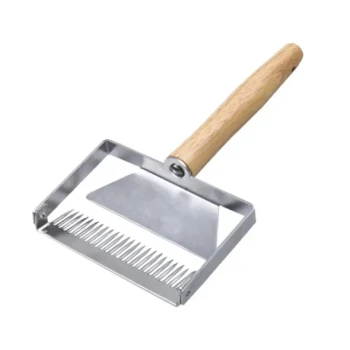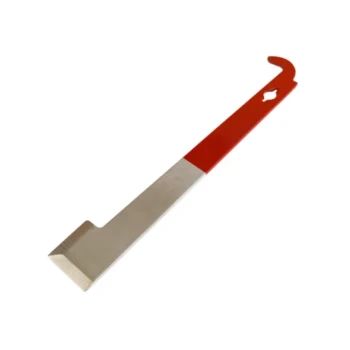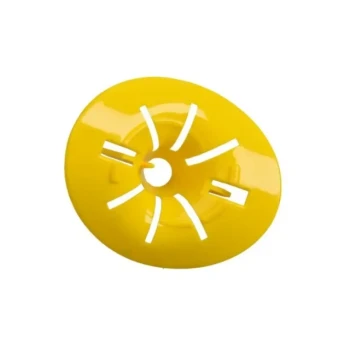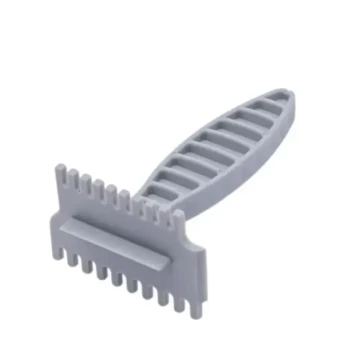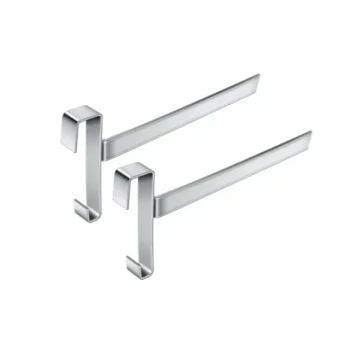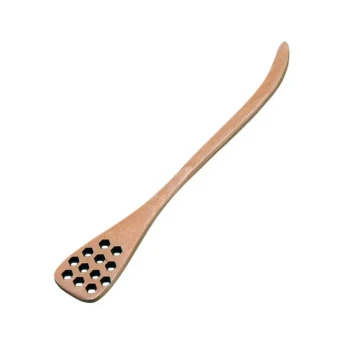The best fuel for a smoker depends entirely on its purpose. For cooking, the best fuels are wood pellets or chips chosen specifically to impart a desired flavor to the food. For a beehive smoker, the best fuels are non-toxic, slow-burning materials like pine needles or cotton scraps that produce a cool, calming smoke to pacify bees without harming them.
Your choice of fuel is dictated by your primary goal. For cooking, the goal is flavor and consistent heat. For beekeeping, the goal is calm and safety. The materials used for each are fundamentally different and should not be interchanged.
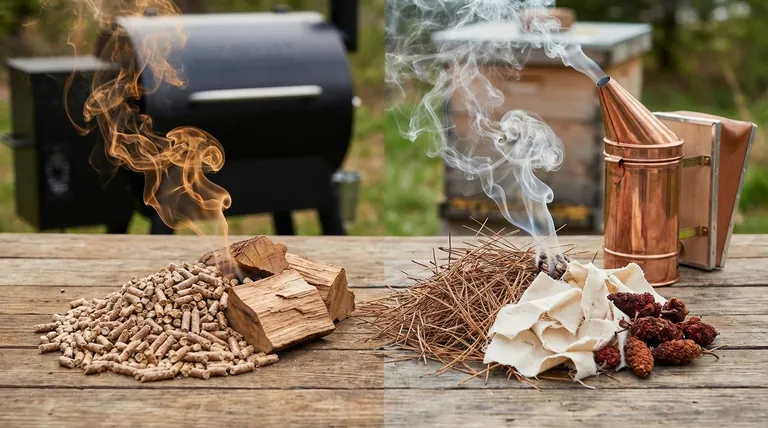
Fuel for BBQ Smokers: The Pursuit of Flavor
When smoking food, the wood is not just a heat source; it is a critical ingredient. The type of wood and its form factor (pellet, chip, or chunk) directly impact the final taste and texture of your food.
The Role of Wood in Flavor
Different types of wood contain unique compounds that, when burned, create distinct smoke profiles. Hardwoods like hickory, mesquite, oak, and fruitwoods like apple or cherry are preferred for their pleasant, aromatic smoke.
Pellets: For Consistency and Ease
Made from compressed sawdust, wood pellets are the fuel of choice for modern pellet smokers. They provide an automated, steady burn that makes temperature control incredibly simple. The variety of wood types available allows for precise flavor pairings with specific meats.
Wood Chips: For Quick Smoke Bursts
Wood chips are small pieces of wood that ignite and burn relatively quickly. They are ideal for adding a rapid infusion of smoke, making them a great choice for shorter cooks or for use in gas and charcoal grills to add a smoky flavor.
Fuel for Bee Smokers: The Goal of Calm
The purpose of a bee smoker is not to generate intense heat or flavor, but to produce a large volume of cool, thick smoke. This smoke masks the bees' alarm pheromones, calming the hive and making it safer for the beekeeper to inspect.
The Primary Goal: Cool, Non-Toxic Smoke
The fuel must burn slowly and at a low temperature to avoid harming the bees with excessive heat or noxious fumes. The absolute priority is the health and safety of the colony.
Safe and Common Fuel Sources
Beekeepers have a range of reliable, safe options. Good kindling fuels that ignite easily include pine shavings and dry pine needles. For a longer, steadier burn, these can be topped with heavier fuels like untreated wood chips, all-cotton cloth scraps, or dried staghorn sumac bobs.
Materials to Strictly Avoid
Never use fuel that could be toxic to bees. This includes any chemically-treated plant matter, wood from pressure-treated lumber, and toxic plants like poison ivy. Densely packed sawdust should also be avoided as it can inhibit airflow and burn poorly.
Understanding the Trade-offs
Choosing a fuel source always involves balancing competing factors. Recognizing these trade-offs is key to mastering your craft, whether you are a pitmaster or a beekeeper.
BBQ: Convenience vs. Control
Pellet smokers offer unparalleled convenience and "set-it-and-forget-it" operation. However, traditional offset smokers burning wood chunks or logs give the pitmaster more granular control over the fire and smoke quality, which many purists prefer.
Beekeeping: Burn Time vs. Purity
While tightly rolled cardboard can provide a long burn time, it may contain glues or inks that are harmful to bees. Natural materials like pine needles or untreated twine are safer but may need to be replenished more frequently during a long hive inspection.
Making the Right Choice for Your Goal
Your selection process should begin with a clear understanding of your specific objective.
- If your primary focus is cooking flavorful barbecue: Choose a fuel based on the wood type for flavor (e.g., hickory for pork) and the form factor (pellets, chips) that matches your equipment and desired level of convenience.
- If your primary focus is safely managing a beehive: Choose a fuel that is certified non-toxic, burns slowly and coolly, and is readily available, such as pine needles or untreated cotton fabric.
Ultimately, selecting the right fuel is about matching the material's properties to the specific outcome you need to achieve.
Summary Table:
| Smoker Type | Primary Goal | Recommended Fuels | Key Considerations |
|---|---|---|---|
| BBQ Smoker | Flavor & Consistent Heat | Wood Pellets (Hickory, Apple), Wood Chips | Choose wood type for desired flavor profile; pellets offer ease, chips for quick smoke. |
| Bee Smoker | Calm & Safety | Pine Needles, Cotton Scraps, Untreated Wood Chips | Must be non-toxic, slow-burning, and produce cool smoke to avoid harming bees. |
Upgrade Your Beekeeping Operations with the Right Fuel and Equipment
Whether you're a commercial apiary or a beekeeping equipment distributor, selecting the correct fuel is crucial for hive health and productivity. HONESTBEE supplies high-quality, non-toxic fuel sources and durable beekeeping smokers designed for safety and efficiency.
Let us help you optimize your operations with our wholesale-focused supplies. Contact us today to discuss your needs and explore our full range of beekeeping solutions.
Visual Guide
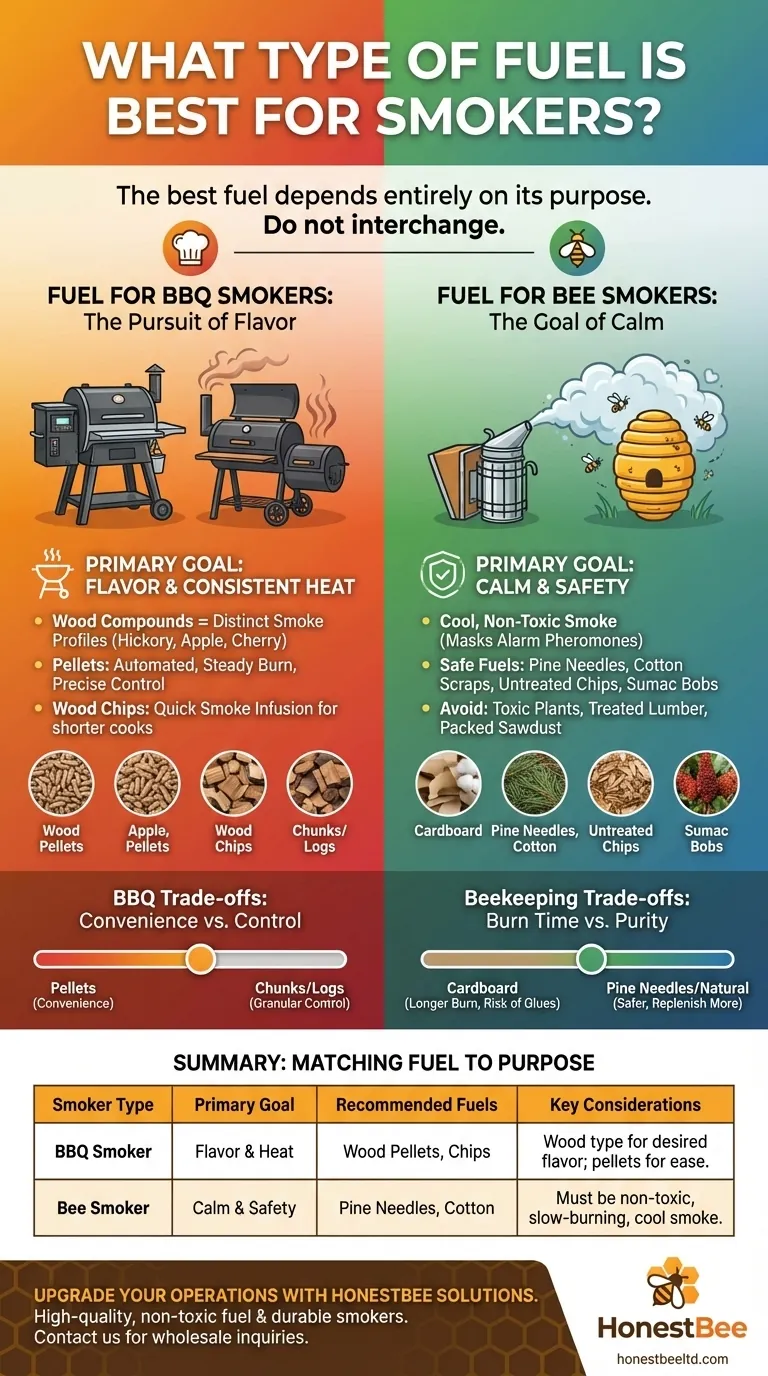
Related Products
- Premium Traditional Copper Bee Smoker with Bellows
- Economy Galvanized Beekeeping Honey Bee Smoker for Wholesale
- Professional Bee Smoker with Elongated Spout and Durable Bellows for Beekeeping
- Wholesales Dadant Size Wooden Bee Hives for Beekeeping
- Long Langstroth Style Horizontal Top Bar Hive for Wholesale
People Also Ask
- What is the primary purpose of using smoke in beekeeping? Calm Bees for Safer Hive Management
- What are the main parts of a bee smoker? Essential Components for Calm Hive Management
- What happens to bees when they sense smoke? Unlock the Secret to Calm Hive Inspections
- How did early beekeepers use bee smokers? Master Ancient Bee Calming Techniques
- How does water mist work as an alternative to smoke in beehives? A Guide to Safe & Effective Use






